Scoutmaster Musings
Archives:
2025 - Jan
2023 2022 2021 2020 2019 2018 2017 2016 2015 2014 2013 2012 2011 2010 2009 2008 2007 2006 2005
 Our second day was great. I saw a Couple elk near our campsite when I woke up. But before that I enjoyed a wonderful view of the big dipper over the mountains when I had to get up at 1:30am.
We got on the trail at 9:30 and had a few miles of pretty tough uphill to a beautiful lunch spot on three tip of a pass. From there, it was a rocky but easy walk down to Elk Lake whee we eventually found a decent spot to camp.
We saw the mouse on the lake and a herd of elk run by. The rocky mountains make for a wonderful backdrop across the lake.
Mac and cheese for dinner, but the chili ramen was spicy.
There was frost on the grass this morning but tonight seems much warmer even though we are 1000 feet higher at 9800 feet.
Our second day was great. I saw a Couple elk near our campsite when I woke up. But before that I enjoyed a wonderful view of the big dipper over the mountains when I had to get up at 1:30am.
We got on the trail at 9:30 and had a few miles of pretty tough uphill to a beautiful lunch spot on three tip of a pass. From there, it was a rocky but easy walk down to Elk Lake whee we eventually found a decent spot to camp.
We saw the mouse on the lake and a herd of elk run by. The rocky mountains make for a wonderful backdrop across the lake.
Mac and cheese for dinner, but the chili ramen was spicy.
There was frost on the grass this morning but tonight seems much warmer even though we are 1000 feet higher at 9800 feet. | Leave Comment |
 Our first day of hiking and camping was a great opportunity to get a rhythm going. We only covered about 3.5 miles from Hunter trailhead to Triangle Park, but we had a couple water crossings, tough trail, and dust. The crew found a very nice campsite secluded just in the trees with a nice view across the meadow. It's really hard to see that we are here.
Our first dinner and clean up could have gone better but it tasted great and Mrs. Dude and I did the dishes. That's Mrs. Dude crossing the stream, too.
Just a gorgeous day with a few puffy clouds, nice breeze, no humidity, and few mosquitoes this evening. A couple guys fished in a tiny creek. One guy helped fix my fly pole. :-)
Didn't see any animals except horse.
Really to bed and the temp is dropping so we should sleep well.
Our first day of hiking and camping was a great opportunity to get a rhythm going. We only covered about 3.5 miles from Hunter trailhead to Triangle Park, but we had a couple water crossings, tough trail, and dust. The crew found a very nice campsite secluded just in the trees with a nice view across the meadow. It's really hard to see that we are here.
Our first dinner and clean up could have gone better but it tasted great and Mrs. Dude and I did the dishes. That's Mrs. Dude crossing the stream, too.
Just a gorgeous day with a few puffy clouds, nice breeze, no humidity, and few mosquitoes this evening. A couple guys fished in a tiny creek. One guy helped fix my fly pole. :-)
Didn't see any animals except horse.
Really to bed and the temp is dropping so we should sleep well.
| Leave Comment |
 Heading into the mountains of Wyoming for a week of backpacking this afternoon. This is our campsite in Buffalo last night with the Bighorns in the background. A forest fire on the west side made us change route but weather should be great, so it's all good.
Heading into the mountains of Wyoming for a week of backpacking this afternoon. This is our campsite in Buffalo last night with the Bighorns in the background. A forest fire on the west side made us change route but weather should be great, so it's all good. | Leave Comment |

 Well, tomorrow his wheel hits the Pacific!
Well, tomorrow his wheel hits the Pacific! My Eagle Scout son completes his Atlantic to Pacific solo bicycle ride from Boston, MA to Anacortes, WA. It has been fun following his progress from sea to sea, covering over 3800 miles, on his blog at BikingDude.com This is his starting photo and I look forward to seeing its twin posted soon.
I now understand a bit more how family back home feel when I'm out hiking for a month. It was a bit stressing when he didn't blog a few days after getting used to seeing his report each day. We were helpless to assist when he had mechanical problems. I could only imagine how much work it took to climb mountain passes, how hot it was across the prairie, and how close traffic came on narrow shoulders. It's a lot easier being the one out there doing the thing than it is being home.
The most enjoyable part for me was to hear how he met many friendly, helpful people just as I often do on my long hikes. A long excursion makes the world a bit smaller and shows that there is certainly a lot more good out there than we usually hear about.
He still has more road to ride. He plans to bike down to San Francisco to visit friends and then see what's next. You'll have to check out his blog to see what happens.
My next (much smaller) adventure starts tomorrow. I'll be leading a group backpacking in the Cloud Peak Wilderness of Wyoming for just a week. It is forecast to be a super week with great weather, fishing, hiking, mountains, wildlife, and as a special treat - my wife will be on the trek. She's not been backpacking in many years, so my fingers are crossed that she'll catch the bug to go on more adventures.
| Leave Comment |
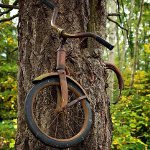
 Besides doing some morning hikes in preparation for leading a week-long trek in the Wyoming wilderness in a couple weeks, I've been living vicariously through my oldest son's bicycle trip across the country. He has my Spot device to track his progress, and I created a website for him to blog about his travels.
Besides doing some morning hikes in preparation for leading a week-long trek in the Wyoming wilderness in a couple weeks, I've been living vicariously through my oldest son's bicycle trip across the country. He has my Spot device to track his progress, and I created a website for him to blog about his travels.If you'd like to check in on an Eagle Scout riding from the Atlantic to Pacific oceans, just check out BikingDude.com and leave him a comment of encouragement. Today, he's halfway through Montana, having started in Boston!
| Leave Comment |
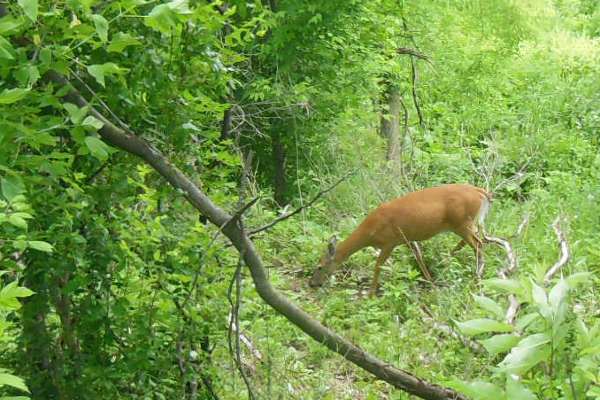
 The animals along the local trails are so nonchalant about humans, it's scary. This deer couldn't care less that I walked by no more than 15 feet from it. I almost stepped on a rabbit before it decided to saunter, not hop, rocket, dodge, bolt, scurry, or run, but just saunter off the trail. Yesterday, two squirrels chased right across the trail, no more than 3 feet in front of me, just playing games and oblivious to my ominous presence.
The animals along the local trails are so nonchalant about humans, it's scary. This deer couldn't care less that I walked by no more than 15 feet from it. I almost stepped on a rabbit before it decided to saunter, not hop, rocket, dodge, bolt, scurry, or run, but just saunter off the trail. Yesterday, two squirrels chased right across the trail, no more than 3 feet in front of me, just playing games and oblivious to my ominous presence.People don't feed these animals, but the trail corridor is a nice green space for them and they are just used to humans walking by. Bicyclists also use the trail and I expect to start seeing some "trailkill" soon as the little critters ignore the danger. Now, if a deer doesn't get out of the way, that will be something interesting!
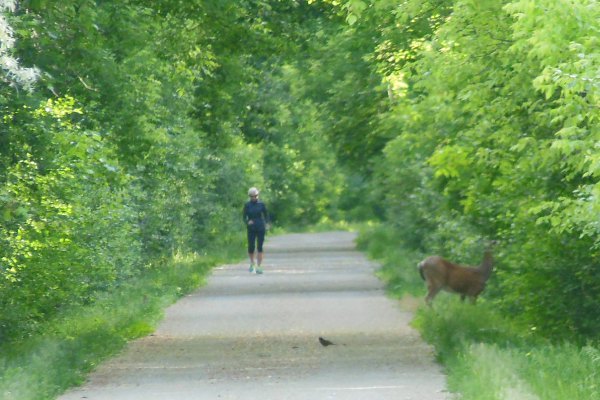
 This is a great time of year for seeing how many different kinds of animals you can find. I routinely count 10 different kinds every morning.
This is a great time of year for seeing how many different kinds of animals you can find. I routinely count 10 different kinds every morning.So, who has the right-of-way when a human, bird, and deer all want the same space? :-)
Keep your eyes and ears open for animals when walking, riding, or driving. The young'uns are growing quickly and exploring away from protective parents, so you might get to see some closer than usual - and maybe too close if you're not careful.
| See 3 comments | Leave Comment |
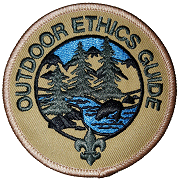

Outdoor Code + Leave No Trace + Tread Lightly + Land Ethic = Outdoor Ethics
Just like that little equation might be confusing, there's been some confusion about the Outdoor Ethics part of the Boy Scouts of America program.
I've heard BSA is breaking ties with Leave No Trace.
I've heard BSA is moving to Tread Lightly! instead of Leave No Trace.
I've heard BSA is creating it's own program.
Those are all incorrect.
The concept of being good stewards of the outdoors is not new to the BSA. Tag lines, catch phrases, logos, promotions, and even best practices come and go, but the underlying desire to use, protect, and conserve outdoor recreational areas remains. The BSA program tries to incorporate the best available study results, partnerships, guidelines, and principles to ensure its members minimize impact while maximizing benefit when participating in outdoor activities.
The BSA's Outdoor Ethics encompasses the principles of Tread Lightly! for motorized activities, Leave No Trace for non-motorized activities, Aldo Leopold's Land Ethic, and the BSA's Outdoor Code for continuity - all mantras being very similar and overlapping in many ways.
Outdoor Code
As an American, I will do my best to be:
- Clean in my outdoor manners -
We will clean up after ourselves using pack it in, pack it out techniques. We avoid leaving graffiti, fire rings, camp gadgets, and other signs of our presence. - Careful with fire -
Fire is an important tool, but one that can be devastating if it gets out of hand. We think about the need for fire, how best to use it, and how to minimize its impacts. - Considerate in the outdoors -
We will think about others as well as ourselves and how our presence impacts them. We think about not just our impact on other humans, but also on wildlife and the environment. - Conservation minded -
We will think about our impacts on the environment. We take steps to correct and redress damage to the environment.
Leave No Trace Principles
- Plan Ahead and Prepare
- Use Durable Surfaces
- Dispose of Waste Properly
- Leave What You Find
- Minimize Campfire Impact
- Respect Wildlife
- Courtesy to Others
Tread Lightly! Principles
- Travel Responsibly on land by staying on designated roads, trails and areas. Go over, not around, obstacles to avoid widening the trails. Cross streams only at designated fords. When possible, avoid wet, muddy trails. On water, stay on designated waterways and launch your watercraft in designated areas.
- Respect the Rights of Others including private property owners, all recreational trail users, campers and others so they can enjoy their recreational activities undisturbed. Leave gates as you found them. Yield right of way to those passing you or going uphill. On water, respect anglers, swimmers, skiers, boaters, divers and those on or near shore.
- Educate Yourself prior to your trip by obtaining travel maps and regulations from public agencies. Plan for your trip, take recreation skills classes and know how to operate your equipment safely.
- Avoid Sensitive Areas on land such as meadows, lakeshores, wetlands and streams. Stay on designated routes. This protects wildlife habitats and sensitive soils from damage. Don't disturb historical, archeological or paleontological sites. On water, avoid operating your watercraft in shallow waters or near shorelines at high speeds.
- Do Your Part by modeling appropriate behavior, leaving the area better than you found it, properly disposing of waste, minimizing the use of fire, avoiding the spread of invasive species and repairing degraded areas.
Land Ethic
The Land Ethic reflects Scouting's historic commitment to conservation and service. It challenges us to include "the land" (soil, water, plants, animals, air, all of nature) as part of our community to love and respect, rather than to conquer and subdue. Ethics direct individuals to cooperate with each other for the mutual benefit of all. The premise of the Land Ethic is that we must include nature in our view of mutual benefit or else we will only see it as a resource to exploit, consume, and discard.
New 2016 Boy Scout Requirements
Each of the first four ranks includes a piece of the Outdoor Ethics picture. These expand on previous requirements and require a more broad understanding of our outdoor ethic. If your troop just follows the principles as "the way we camp", then new scouts will pick up the skills quickly. They may not even realize that they are doing things a certain way in order to minimize their impact - and that would be very cool.
- Scout 1e Repeat from memory the Outdoor Code. In your own words, explain what the Outdoor Code means to you.
- Tenderfoot 1c: Tell how you practiced the Outdoor Code on a campout or outing.
- Second Class 1b:Explain the principles of Leave No Trace and tell how you practiced them on a campout or outing. This outing must be different from the one used for Tenderfoot requirement 1c.
- First Class 1b:Explain each of the principles of Tread Lightly! and tell how you practiced them on a campout or outing. This outing must be different from the ones used for Tenderfoot requirement 1c and Second Class requirement 1b.
Outdoor Ethics Guide
The Leave No Trace Traininer position of responsibility is no more. Instead, we now have the Outdoor Ethics Guide position.
The outdoor ethics guide helps the troop plan and conduct an outdoor program that emphasizes effectively practicing the principles of outdoor ethics. He works to help Scouts improve their outdoor ethics decision-making skills to minimize impacts as they participate in outdoor activities. The guide supports Scouts who are working to complete the relevant requirements for the Tenderfoot, Second Class and First Class ranks.
While the LNT Trainer position required a scout to be at least 14 years old and attend a 16-hour training class, the OE Guide has no training requirement. A scout is appointed to this position by the Senior Patrol Leader, just like other positions of responsibility. But, fulfilling the duties of this position require broad knowledge and developed skills in proper outdoor practices. It makes good sense to have a seasoned scout take on this job to provide adequate leadership to inexperienced scouts so they learn good outdoor ethics - which is much easier than UNlearning bad habits.
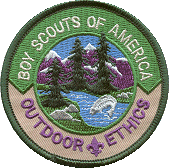
 Outdoor Ethics Awards
Outdoor Ethics Awards
Two awards are available for scouts and Scouters:
- Outdoor Ethics Awareness Award for Cub Scouts or Boy Scouts - an easy recognition to earn by doing a couple online activities and one real world activity.
- Outdoor Ethics Action Award for Cub Scouts or Boy Scouts - expands on the awareness award by implementing the knowledge and sharing with others.
Resources
Here are some web pages with more information about BSA's Outdoor Ethics:
Leave No Trace has been incorporated into the Scout Handbook, program materials, and training for quite a few years now. This latest emphasis in both the Cub Scout and Boy Scout programs shows that the BSA organization understands the need. As a Leave No Trace Master Educator, I'm excited to see the expanded scope. It's now up to the Scoutmasters, Cubmasters, Den Leaders, and other adult volunteers to ensure this education is made part of your unit's program. If you do this, in just a couple years scouts will just think of it as "that's the way we've always done it", and they will be taking care of showing the right way to the new scouts.
If this whole Outdoor Ethics concept is new to you, there are people that can help you grasp it:
- Council Outdoor Ethics Advocate - a council-level volunteer responsible for spreading the word.
- District Outdoor Ethics Advocate - someone in your district to help units develop their OE skills.
- Trainers - Both Leave No Trace and Tread Lightly! have train-the-trainer programs by which they are building armies of trainers that would love to present workshops to your unit, camp, or district.
| See 2 comments | Leave Comment |


Just call me Noah.
My wife, eagle scout son, and I volunteered for a week at Camp Noah in 2014 and my wife and I will be doing it again this summer.
What's Camp Noah?
Camp Noah is a locally hosted day camp for elementary-age children whose communities have been impacted by disaster. Camp Noah provides a safe, caring and fun environment where children build resiliency skills by processing their disaster experience through creative activities and play. Children are encouraged to face their fears, grieve their losses, identify and share their unique gifts and talents, and plan for an amazing future.


Where's Camp Noah?
Camps have been held in 28 states and Puerto Rico. In 2014, we volunteered in Norman, OK after a tornado. This year, we are going to San Marcos, TX because the town was hit hard by severe floods last year.
Whether flood, fire, earthquake, hurricane, or other disaster, Camp Noah is a resource for the community.
What About Scouts?
A goal of Camp Noah is to help children be resilient and prepared for challenges that will inevitably come along. Scouting has similar goals. Scouts also are all about helping people. There are quite a few ways that scouts can be involved in Camp Noah:
- Make Blankets - Every child at camp receives his/her very own fleece blanket to take home. This means hundreds of hand-made blankets are needed - no sewing required! This could be a unique Eagle Scout Project that provides a great service, takes leadership and coordination, and is based on simple skills that any scout could contribute. You could also make Kids Kits and Birthday Cards for the campers. See Projects.
- Volunteer to be on Camp Noah staff. This is what we're doing. It's a great opportunity to support children, learn about a community, and have a lot of fun.
- Host a Camp - If your community has recently been impacted, look into setting up a camp. This could be a great service for a scouting unit to undertake or help with.
When I volunteered, I got to play the role of Noah in a skit each day. That was hard for me, but I expect I'll be asked to do it again - and I'm looking forward to it this time!
Contact the Camp Noah folks to get more info about getting involved.
Unicorn song
Scout On
| Leave Comment |

 Hey, you get an extra day to enter my monthly give-away this month - only a few hours left. Check out my contest page and take a shot.
Hey, you get an extra day to enter my monthly give-away this month - only a few hours left. Check out my contest page and take a shot.Here are a few more contests you might want to enter...
- Scouting magazine gives away stuff. Visit their contest page to enter.
- Boys' Life has contests, too. You can see them all on their contest page - the worst you could do is get a patch.
Scout On and Good Luck
| Leave Comment |
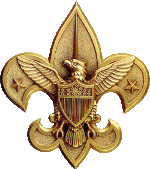

Before my Hike through Florida last month, I contacted some troops in towns along the trail. I hoped to visit with the scouts, share some hiking stories and advice, and encourage them to get out and enjoy the trail in their neighborhood.
I wound up visiting with four troops along the way, and almost one Pack, but it didn't work out. These visits were highlights of my trek and gave me the opportunity to meet fellow scouters, and watch other troops in action.
Close Call in Dade City
The difficulty with arranging a visit while hiking long distances is not knowing how long it will take to reach a location. For example, maybe it's Thursday and I'd like to reach a town on the next Tuesday. If the trail is easier than expected, my legs are strong, and I get up extra early, I might arrive on Sunday. On the other hand, a rough trail, a couple big rain storms, and a few bad nights sleeping might slow me down to Wednesday.
Walking west from Kissimmee, I was hoping to meet the adventurous cub scouts of Pack 301 in Dade City. The hope was I could visit a pack meeting on Monday night. But, I was flying down the trail and would arrive easily by Saturday night. I couldn't just slow my pace or take days off and waste two days of hiking.
So, texting my contact in the pack, we looked at having me join them on their campout on Saturday night. I thought that would be cool, since it didn't matter to me if I camped in my tent in this woods or that woods. It would be fun to tell some stories around the campfire, with Purple Gorilla being one of my favorites.
I thought we had logistics worked out so I picked up my pace a bit for a couple days. I would hike an extra 1.5 miles off trail to a trailhead where someone would pick me up and drop me off the next morning. Unfortunately, no one could be found to do the shuttle. As it turned out, the temperature dropped below freezing that Saturday night and only two scouts camped out. Oh well.
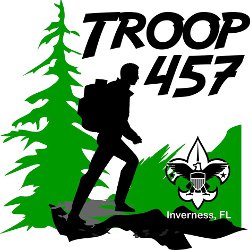

Strong Inverness Scouting
Just two short days later, I arrived in Inverness where I had arranged to meet two troops. Having missed the Dade City scouts, I was really looking forward to this.
I hiked with my cousin's son for the 22 miles into Inverness, moving fast and arriving with a couple hours to rest in a city park before the scoutmaster could pick me up. When he got off work, we went out for a quick dinner with his son and daughter, then off to their troop meeting.
The local Inverness Kiwanis group has just built a new scout hut for Troop 302 and Troop 457 to use. The troops meet on different nights of the week, so it works out great. When I visited, they had a special joint meeting so I could chat with scouts from both troops.
Their scout hut is very, very nice! I'm envious whenever I see a unit with their own meeting place since troops and packs I've volunteered with meet in church basements or school cafeterias. The local support of groups like the Kiwanis helps keep scouting strong and vibrant in communities.
It was a lot of fun talking quickly about my hike, my gear, people and animals I met on the trail, and then answering the dozens of questions. Lots of questions means there is interest, so I really enjoyed that part of the evening. After the meeting, I was allowed to sleep overnight in the scout hut which was a great bonus - I didn't have to set up and pack up my tent. It was fun to meet John and Steve, the two scoutmasters, and get a flavor of how their troops run. All the scouts were polite and attentive.
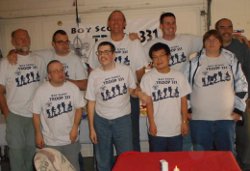

Two Potlucks
Well, I don't know if they call them potlucks in Florida, but I got to enjoy two of them! When I reached Ocala, the scoutmaster of Troop 331 met me on the trail. We had been conversing through email for a few weeks, so it was great to finally meet her. Sue is one of those dedicated scouting volunteers that lives scouting full-time. Troop 331 is a special needs troop, so there tends to be more parent support needed and Sue throws herself into the challenge. She has a ton of support from the other dozen or so parents and they all seem to work well together for the good of their kids.
Before meeting the scouts, I had made a big assumption - I assumed this was a boy scout troop like any other I've visted, just with disabled boys. There is no age limit for scouts with disabilities, so I was surprised to find that the average age of the scouts in Troop 331 must be somewhere around 30. I laughed at myself for making assumptions, yet again.
These guys were great! Outgoing, friendly, courteous, kind, cheerful, ... pretty much everything you'd hope to see in a group of scouts. Sure, some were withdrawn a bit, some were difficult for my unaccustomed ears to understand, and some had repetitive habits that I noticed. But, they were funny. They were fun. They were sincere, welcoming, and proud of their scouting accomplishments. As a matter of fact, one of them (who is 46 years old) will be having his Eagle ceremony on Feb. 27 after working hard to reach that goal.
My time with Troop 331 was a whirlwind of activity. I got a shower, then we met at Gretchen's home for a potluck - and Gretchen's birthday party! Gretchen is a scout's mom and another super person. I got to meet all the scouts - Kale, Chris, Michael, Shawn, Brandon, Eric, Chris, Michael - that could be there, and chat with each of them. After we ate, I was asked to talk a bit about my hiking. There weren't as many questions as I got in Inverness, but it was fun to share my trip. I gave each scout a spoof merit badge that reminded me of them - a super scout, fun meter, smiley face, thumbs up - and some stickers. But, then we got on to the more important activity of celebrating Gretchen's birthday with cake!


The next day, many of the scouts came to Sue's home (where I was staying) and we all had potluck breakfast together. After that, we invaded the local bowling alley for a few games. I'll let you know that I did not get the high score. These guys had been practicing!
Please check out the Disabilities Awareness page at scouting.org for more information on making scouting in your community inclusive.
Troop 100
That evening, I had the pleasure of visiting one more Florida troop - Troop 100. Troop 100 has another very nice scout hut in which to meet - jealous again. The scouts were all in uniform and this struck me as a well-run outfit. Their SPL, Chris, was exceptionally well-mannered and confident. Manners are something I've really noticed here in Florida - lots of "yes, sir", "please", and "thank you" stuff going on all the time.
We ate some food and I talked with the scoutmaster and other adults awhile. It was enjoyable just sitting around with some other men for awhile since I hadn't had the luxury of doing that for the past few weeks. Then, I presented my hike to everyone, followed by a few questions. But, it was getting late so we kept it pretty short.
Impressions
My impressions of Scouting in Florida:
- Manners are used more than other places.
- Uniforms are worn more than other places.
- Units that are surviving, are not just surviving - they are doing very well. They are active and flourishing.
- Some units are not surviving - recent changes in BSA have resulted in lost charters and loss of members in this area.
- Each troop is unique, just like other places - based mostly on the direction of the involved adults.
- Councils are having difficulties with running business as usual, just like other places, and are consolidating.
- Scouts camp more in the winter when the weather is more pleasant, much different than what I'm used to.
It was a great experience meeting these Scouts and Scouters.
Scout On
| Leave Comment |
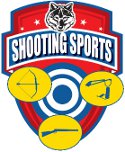

Did you notice there are no shooting activities in the new Cub Scout program adventures? Nothing to replace the old BB Gun and Archery belt loops.
Have no fear! A replacement award is here!
The Cub Scout Shooting Sports award should be available at your local district and council camps this summer. Like the previous program, you can't shoot at Pack events - only at district and council events.
This new program offers a different patch for each rank, plus a different pin device for each style of shooting - Archery, BB Guns, and Slingshots. That should keep scouts interested since they can earn a patch and three pins each year for four years.
Find out more about the Cub Scout Shooting Sports award and check with your local council folks to find out when it will be ready for your scouts.
Scout On
| Leave Comment |
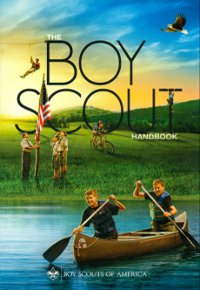

The new 2016 13th Edition of the Boy Scout Handbook should be in the hands of every new scout joining your troop this year. The new edition made what I believe to be some nice improvements, along with just a couple things not so much.
- The distracting background images found on most pages are gone. This makes it much easier to read the crisper, black text.
- Overlapping, skewed, faded out images are replaced with bold, obvious, correctly oriented images. This draws attention to the image as a helpful device rather than a decoration.
- Each topic chapter lists the advancement requirements covered in the chapter. This is nice, but I doubt will be used much because...
- The requirements list for each rank in the back of the handbook had page numbers where info for that requirement is found. The page numbers are gone.
- It's only 10 pages longer than the previous edition, but the heavier paper makes it bulkier.
How's It Going?
So, how are those new 2016 Boy Scout requirements going over in your troop?
Certainly by now, the scoutmaster has met with the senior patrol leader to explain the changes.
And, the SPL has passed on the new expectations to his PLC.
And, the Patrol Leaders have discussed the changes with their patrols at a patrol meeting recently.
And, Troop Guides and Instructors are ready to teach skills for the requirements to new scouts.
All the scouts are now working the new requirements.
The troop's advancement chair has explained the changes to the troop committee and interested adults.
The scoutmaster met with his/her assistants and everyone is aware of the new requirements.
If all that has not yet happened in your troop, (alarms blaring, red lights flashing) your next troop meeting and committee meeting should be dedicated to those items!
Transition Time
2016 is a transition year for the new requirements.
- Scouts joining a troop after December 31, 2015 must use the new requirements.
- Scouts working on Tenderfoot, Second Class, and First Class in 2015 may continue to use the old requirements up to First Class. They must use new requirements for Star rank and above.
- Scouts working on Star, Life, or Eagle on December 31, 2015 may complete that specific rank using the old requirements. They must use new requirements for all subsequent ranks.
Starting on January 1, 2017, all scouts must use the new requirements for all rank advancement. For example, if they are a Second Class scout nearly done with the old First Class, they must convert to the new requirements.
Even though some scouts don't have to use the new requirements this year, it makes sense to have just about everyone use them. Those few scouts with just a couple requirements left for a rank should finish up, and then use the new requirements from then on. But, it's up to the scout to decide.
Little Help Here
There are two documents that may be useful for scouts managing their advancement during the transition:
For your Troop Guides teaching scouts the skills for advancement, these documents might be useful:
I believe the relevant pages of Boy Scout Trail have been updated to the 2016 requirements. If you find some that are outdated, I'd appreciate hearing from you.
Scout On,
Scouter Paul
| Leave Comment |
Comments:
Feb 25, 2023 - Joe Patterson
Mar 16, 2023 - Adam John
Jan 21, 2024 - Johnna Downing
Scouting 2025 - Ask a Question - Add Content
Just for Fun: Socializing merit badge




Find more Scouting Resources at www.BoyScoutTrail.com



Follow Me, Scouts
Recent Comments